
Hyperbaric oxygen therapy involves breathing pure oxygen in a pressurized room or tube. Hyperbaric oxygen therapy is a well-established treatment for decompression sickness, a hazard of scuba diving. Other conditions treated with hyperbaric oxygen therapy include serious infections, bubbles of air in your blood vessels, and wounds that won’t heal as a result of diabetes or radiation injury.
In a hyperbaric oxygen therapy chamber, the air pressure is increased to three times higher than normal air pressure. Under these conditions, your lungs can gather more oxygen than would be possible breathing pure oxygen at normal air pressure.
Your blood carries this oxygen throughout your body. This helps fight bacteria and stimulate the release of substances called growth factors and stem cells, which promote healing.
Your body’s tissues need an adequate supply of oxygen to function. When tissue is injured, it requires even more oxygen to survive. Hyperbaric oxygen therapy increases the amount of oxygen your blood can carry. An increase in blood oxygen temporarily restores normal levels of blood gases and tissue function to promote healing and fight infection.
Hyperbaric oxygen therapy is used to treat several medical conditions and medical institutions use it in different ways. Your doctor may suggest hyperbaric oxygen therapy if you have one of the following conditions:
- Anemia, severe
- Brain abscess
- Bubbles of air in your blood vessels (arterial gas embolism)
- Burn
- Decompression sickness
- Carbon monoxide poisoning
- Crushing injury
- Deafness, sudden
- Gangrene
- Infection of skin or bone that causes tissue death
- Non healing wounds, such as a diabetic foot ulcer
- Radiation injury
- Skin graft or skin flap at risk of tissue death
- Vision loss, sudden and painless
What You Can Expect
Hyperbaric oxygen therapy typically is performed as an outpatient procedure and doesn’t require hospitalization. If you’re already hospitalized and require hyperbaric oxygen therapy, you’ll remain in the hospital for therapy or you’ll be transported to a hyperbaric oxygen facility that’s separate from the hospital.
During hyperbaric oxygen therapy, the air pressure in the room is about two to three times normal air pressure. The increased air pressure will create a temporary feeling of fullness in your ears — similar to what you might feel in an airplane or at a high elevation. You can relieve that feeling by yawning or swallowing.
For most conditions, therapy lasts approximately two hours. Members of our health care team will monitor you and the therapy unit throughout your treatment.
Results
To benefit from hyperbaric oxygen therapy, you’ll likely need more than one session. The number of sessions depends on your medical condition. Some conditions, such as carbon monoxide poisoning, might be treated in three visits. Others, such as nonhealing wounds, may require 20 to 40 treatments.
Hyperbaric oxygen therapy alone can often effectively treat decompression sickness, arterial gas embolism and severe carbon monoxide poisoning.
To effectively treat other conditions, hyperbaric oxygen therapy is used as part of a comprehensive treatment plan and administered with other therapies and drugs that fit your individual needs.

*Individual Results May Vary

Apply Now










